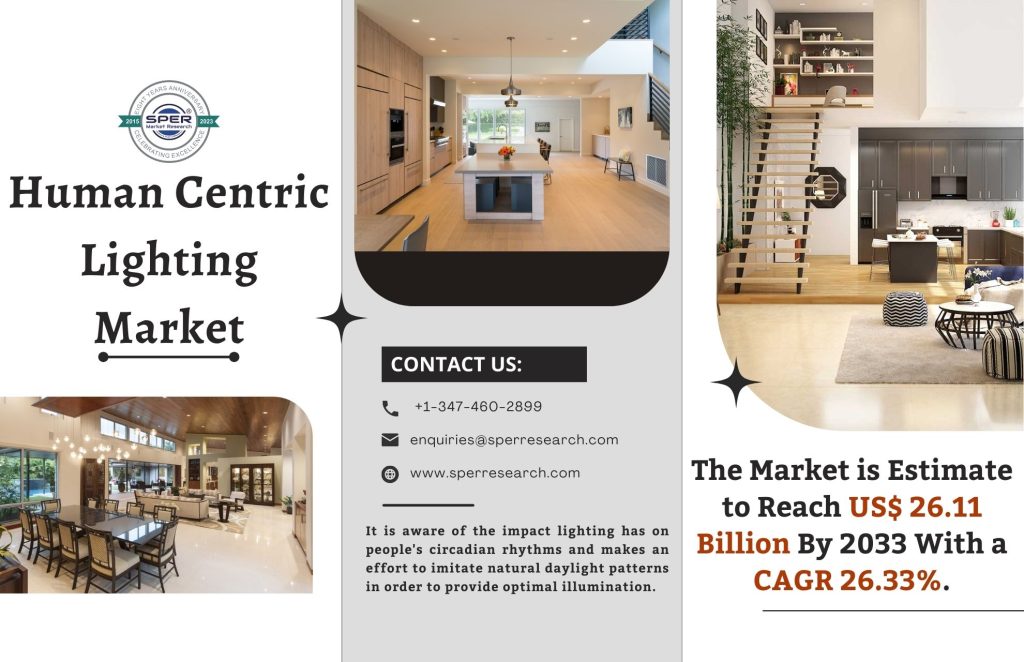“Human centric lighting” is a lighting concept that prioritizes employees’ well-being and productivity in the workplace. It is aware of the impact lighting has on people’s circadian rhythms and makes an effort to imitate natural daylight patterns in order to provide optimal illumination. One clever lighting design approach that can significantly raise employee productivity and quality of life at work is used by HCL. By using HCL solutions to arrange lighting to match with the biological clock, businesses may encourage focus, alertness, and overall wellbeing. As a result, worker fatigue may be reduced, concentration may be improved, and output may increase. HCL also has the ability to raise people’s contentment and general well-being at work.
According to SPER market research, ‘Human Centric Lighting Market Size- By Component Type, By Installation Type, By Application- Regional Outlook, Competitive Strategies and Segment Forecast to 2033’ state that the Human Centric Lighting Market is predicted to reach 26.11 billion by 2033 with a CAGR of 26.33%.
Over the course of the projection period, it is anticipated that the global market for human-centric lighting would grow significantly. The growing requirement for energy-efficient lighting, the quick development of smart lighting systems, and the increasing adoption of LED lighting solutions are all contributing to the growth of the human-centered lighting market. Low-power technology development is highly necessary because most systems are electrical or electronic and need power and energy sources to operate. The depletion of different energy sources has led to a rise in the development of energy-efficient technologies. Human-centric LED lighting fixtures use a great deal less energy than traditional lighting solutions, which reduces energy expenses and aids in meeting carbon-sensitive goals.
One of the barriers in this sector is the high expense of switching from traditional lighting systems to human-centric lighting systems. Maintaining the mood requires ambient lighting, which can be expensive to install initially. The market for human-centric lighting is being hampered by this factor. In the future, nevertheless, it is anticipated that factors like declining LED pricing and a strong return on investment in human-centered lighting would lessen the impact. Also, one of the biggest problems the human-centric lighting industry is facing is the absence of common standards. Because there are no defined standards and regulations for LED and other light sources, manufacturers’ specifications for their products vary from place to place.
Request For Free Sample Report @ https://www.sperresearch.com/report-store/human-centric-lighting-market.aspx?sample=1
Impact of COVID-19 on Global Human Centric Lighting Market
The COVID-19 pandemic had a substantial effect on the market’s growth. Even while the disruptions included supply chain delays, project postponements due to lockdowns, and volatility in the financial position, they also demonstrated the importance of human-centric lighting. The pandemic accelerated the demand for lighting solutions that prioritize the safety of patients and healthcare personnel in healthcare settings, especially hospitals.
Global Human Centric Lighting Market Key Players:
Over the course of the projection period, the human-centric lighting market is anticipated to grow at the fastest rate in Asia Pacific. The market for human-centric lighting in Asia has tremendous growth potential because the region is seeing a huge increase in construction activity, which is fueling the market’s expansion. Significant competitors in the market also include Hubbell Incorporated, OSRAM GmbH, Zumtobel Group AG, Fagerhult Group, and other well-known companies.
Human Centric Lighting Market Key Segments Covered
The SPER Market Research report seeks to give market dynamics, demand, and supply forecasts for the years up to 2033. This report contains statistics on product type segment growth estimates and forecasts.
By Component Type: Based on the Component Type, Global Human Centric Lighting Market is segmented as; Sensors, Drivers, Microprocessor & Microcontrollers, Switches & Dimers, Transmitter & Receivers, Others.
By Installation Type: Based on the Installation Type, Global Human Centric Lighting System Market is segmented as; New Installations, Retrofit Installations, Others.
By Application: Based on the Application, Global Human Centric Lighting Market is segmented as; Wholesale & Retail, Enterprises & Data Centres, Residential, Educational Institutions, Healthcare, Industrial, Hospitality, Others.
By Region: This research also includes data for North America, Asia-Pacific, Latin America, Middle East & Africa and Europe.
This study also encompasses various drivers and restraining factors of this market for the forecast period. Various growth opportunities are also discussed in the report.
For More Information, refer to below link:-
Human Centric Lighting Market Future Outlook
Related Reports:
Follow Us –
LinkedIn | Instagram | Facebook | Twitter
Contact Us:
Sara Lopes, Business Consultant — U.S.A.
SPER Market Research
+1-347-460-2899



